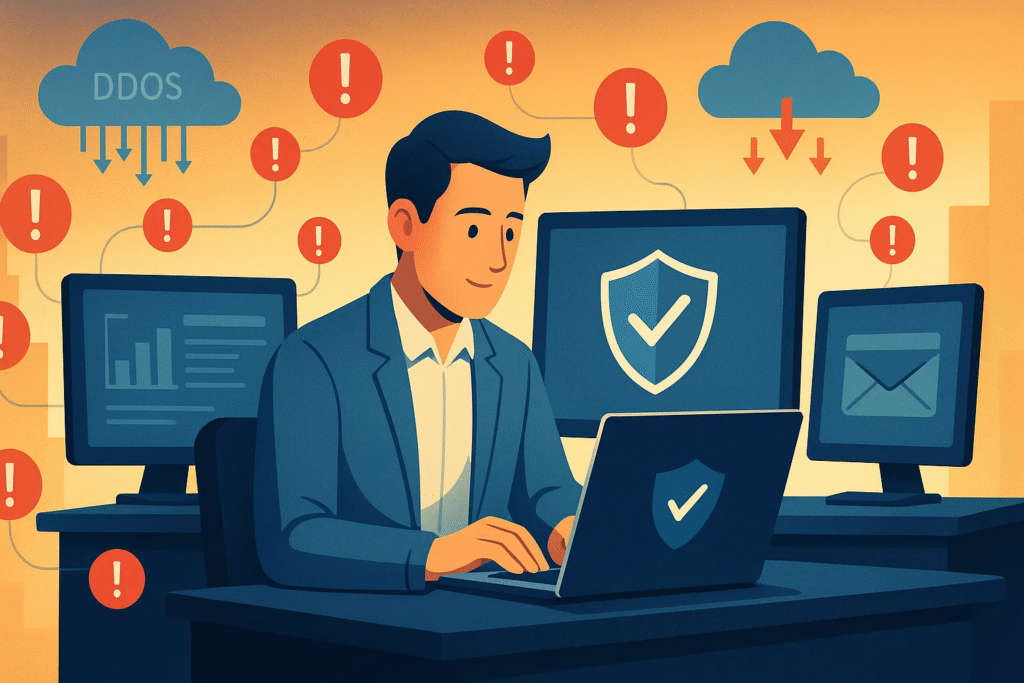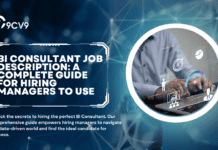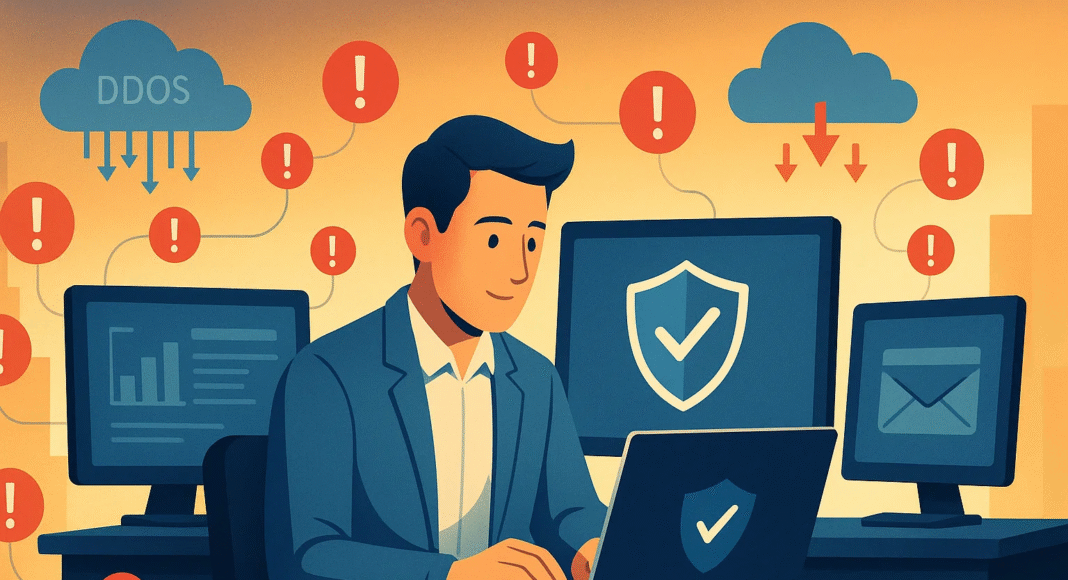Key Takeaways
- Discover the top 10 DDoS protection software solutions in 2025, featuring advanced threat detection and mitigation capabilities for all business sizes.
- Compare key features such as scalability, AI-driven defense, and multi-layer protection to find the most effective DDoS mitigation tools.
- Understand pricing models, deployment options, and performance metrics to make an informed decision for securing your digital infrastructure.
In today’s hyperconnected world, where businesses, organizations, and individuals rely heavily on uninterrupted digital services, cybersecurity has become more critical than ever.
Among the most disruptive threats facing online platforms is the Distributed Denial-of-Service (DDoS) attack — a malicious attempt to overwhelm a target’s server, service, or network with a flood of internet traffic.
As digital infrastructure continues to grow in complexity and scale, so too does the sophistication of DDoS attacks, making robust DDoS protection software an indispensable component of any cybersecurity strategy in 2025.

The frequency, intensity, and ingenuity of DDoS attacks have escalated dramatically over the years.
Attackers now employ advanced tactics such as multi-vector assaults, botnet-fueled traffic surges, and even AI-assisted exploits that can bypass traditional security mechanisms.
Whether targeting e-commerce platforms, SaaS providers, financial institutions, or public services, these attacks can lead to devastating consequences including downtime, reputational damage, data loss, and significant financial losses.
In fact, recent industry reports indicate that the average cost of a successful DDoS attack has surpassed six figures, a number that continues to climb annually.
Against this backdrop, investing in reliable and intelligent DDoS protection software is no longer optional—it is mission-critical.
But with a crowded cybersecurity marketplace and countless vendors promising the ultimate solution, how do you determine which DDoS protection tool is right for your needs?
From cloud-native solutions with AI-driven traffic analysis to hybrid models offering granular control and custom mitigation strategies, the landscape is rich with innovation yet often overwhelming to navigate.
This comprehensive guide aims to cut through the noise by presenting the Top 10 Best DDoS Protection Software to Try in 2025, carefully curated based on performance, scalability, ease of deployment, customer satisfaction, and advanced threat mitigation features.
Whether you’re a small business seeking affordable and automated protection or a large enterprise needing enterprise-grade capabilities and real-time analytics, this list includes solutions tailored to every use case and budget.
In compiling this list, we’ve analyzed the latest trends, expert reviews, case studies, and technical benchmarks to ensure our recommendations reflect the evolving cybersecurity environment of 2025. From providers that excel in low-latency detection to those offering robust API integration and 24/7 SOC support, each software solution highlighted here has been selected for its proven ability to defend against even the most complex DDoS attacks.
Read on to discover the most trusted, cutting-edge, and high-performing DDoS protection software available this year, and take the first step toward fortifying your digital assets against one of the most persistent threats in the cyber world.
Before we venture further into this article, we would like to share who we are and what we do.
About 9cv9
9cv9 is a business tech startup based in Singapore and Asia, with a strong presence all over the world.
With over nine years of startup and business experience, and being highly involved in connecting with thousands of companies and startups, the 9cv9 team has listed some important learning points in this overview of the Top 10 Best DDoS Protection Software To Try in 2025.
If your company needs recruitment and headhunting services to hire top-quality employees, you can use 9cv9 headhunting and recruitment services to hire top talents and candidates. Find out more here, or send over an email to [email protected].
Or just post 1 free job posting here at 9cv9 Hiring Portal in under 10 minutes.
Top 10 Best DDoS Protection Software To Try in 2025
- Cloudflare DDoS Protection
- Radware DefensePro and Cloud DDoS Protection
- Imperva DDoS Protection
- Azure DDoS Protection
- Fastly DDoS Protection
- Google Cloud Armor
- NETSCOUT Arbor Threat Mitigation System (TMS)
- F5 Distributed Cloud DDoS Mitigation
- Check Point Quantum
- Prophaze DDoS Protection
1. Cloudflare DDoS Protection
Cloudflare remains one of the most formidable players in the DDoS mitigation landscape in 2025. Positioned as a leader in both performance and global reach, the company has continuously evolved its platform to address the changing nature of cyber threats. From small-scale websites to global enterprises, Cloudflare delivers scalable DDoS protection that merges performance with intelligent threat analytics, backed by one of the largest networks in the world.
Overview of Cloudflare’s Cybersecurity Ecosystem
Cloudflare’s DDoS protection service is part of a broader suite of cloud-based security and performance solutions designed to simplify and secure digital operations at scale.
- Core Capabilities Beyond DDoS Protection:
- Web Application and API Protection (WAAP)
- Secure Access Service Edge (SASE)
- Security Service Edge (SSE)
- Software-Defined Wide Area Networking (SD-WAN)
- Edge Developer Services
- Content Delivery Network (CDN) Infrastructure
- Network Reach:
- Global capacity: 321 Tbps
- Coverage: 330 cities worldwide
- Advantage: Provides a wide geographical defense footprint with minimal latency and regional intelligence
DDoS Mitigation Features and Technologies
Cloudflare employs advanced mitigation technologies specifically designed to detect, analyze, and neutralize even the most complex DDoS attacks in real time.
- Key Defensive Capabilities:
- Unmetered DDoS protection — Fixed pricing regardless of attack volume
- On-the-fly signature generation — Immediate response to novel attack patterns
- Intelligent traffic filtering — Ensures legitimate traffic flows uninterrupted
- Hybrid deployment support — Available for both hardware integration and cloud-native environments
- Low false-positive rate — Accuracy-driven filtering to prevent service disruption
- Notable Innovations:
- Rapid threat mitigation time: Most volumetric attacks neutralized within 35 to 45 seconds
- Argo Smart Routing and Load Balancing (optional) for performance optimization
Quantified DDoS Defense Performance – Q1 2025 Snapshot
Cloudflare has demonstrated unparalleled performance in DDoS mitigation, backed by real-world metrics collected during live attack scenarios.
Cloudflare DDoS Mitigation – Performance Matrix (Q1 2025)
| Metric | Value | YoY Growth | QoQ Growth |
|---|---|---|---|
| Total DDoS Attacks Mitigated | 20.5 million | +358% | +198% |
| Network-Layer Attacks Blocked | 16.8 million | +509% | N/A |
| Hyper-Volumetric Attacks Blocked (≥1 Tbps/Bpps) | 700+ | N/A | N/A |
| Largest Attack Mitigated | 6.5 Tbps | – | – |
| Peak PPS Attack Blocked | 4.8 Bpps | – | – |
| Time to Mitigate Peak Attack | ~35–45 seconds | – | – |
| Average Attack Duration | < 90 seconds | – | – |
Pricing Model and Tier Structure
Cloudflare offers flexibility through a tiered pricing system, enabling accessibility for a wide range of users from individuals to large-scale enterprises.
- Pricing Tiers:
- Free Plan — Suitable for personal blogs or small websites; includes basic CDN and DDoS protection
- Pro Plan — Starting at $20/month; adds WAF and performance features
- Business Plan — Priced at $200/month; includes advanced security and analytics
- Enterprise Plan — Custom pricing with tailored SLAs and onboarding
- Optional Add-ons:
- Argo Smart Routing and Load Balancing: from $5/month
- Partner platforms: Enterprise CDN, WAF, and DDoS available from $4.99/month/domain
Customer Ratings and Sentiment Analysis
User sentiment around Cloudflare remains strongly positive, reflecting satisfaction with its performance, ease of use, and global resilience.
- User Ratings Overview:
- Gartner Peer Insights: 4.5/5 (278 reviews)
- G2: 4.5/5 (533 reviews)
- PeerSpot Mindshare (May 2025): 19.6% in DDoS protection (↑ from 19.2% in 2024)
- Strengths Highlighted by Users:
- High-performance global infrastructure
- Intuitive configuration interface
- Low-latency and near-instant mitigation
- Exceptional reliability and availability
- Solid CDN integration and performance optimization
- Common Concerns:
- Technical support limitations — Primarily a self-service model
- Complexity — Some users find the UI unintuitive for advanced configurations
- Pricing at scale — Add-ons and advanced features can become costly
- Limited protection against advanced application-layer attacks — Particularly “low-and-slow” or highly obfuscated attacks mimicking legitimate traffic
Key Use Cases and Ideal Deployment Scenarios
Cloudflare is well-suited for a diverse set of environments, making it a preferred solution across industries and use cases.
- Recommended For:
- High-traffic eCommerce platforms
- SaaS and PaaS providers
- Financial and banking infrastructure
- Media streaming services
- Public sector and governmental websites
- Best Fit When:
- Organizations require unmetered volumetric attack defense
- Teams need scalable protection without hardware investments
- Businesses seek global availability with minimal latency
- Enterprises prioritize CDN integration + WAF + DDoS within a unified dashboard
Limitations and Strategic Considerations
While Cloudflare’s DDoS mitigation engine is among the best in class, potential users should assess its fit against specific threat models.
- Not Ideal If:
- Deep L7 application protection is required without custom WAF rules
- Hands-on technical support is a top priority
- Budget constraints prevent access to premium features or enterprise-grade plans
- Security Strategy Suggestion:
- Combine Cloudflare’s network-level DDoS defense with fine-tuned WAF rules
- Incorporate bot management tools for advanced threat obfuscation scenarios
- Leverage Cloudflare’s API integration to monitor and act on traffic anomalies in real time
Conclusion: A High-Performance, Global Defender Against DDoS in 2025
Cloudflare’s reputation as a DDoS protection leader in 2025 is underpinned by its massive global infrastructure, intelligent mitigation technologies, and scalable pricing models. While it excels in volumetric mitigation, users with complex Layer 7 threats should consider supplementary configurations or integrations. Overall, Cloudflare is a top-tier solution for businesses seeking predictable costs, global reach, and robust DDoS defense.
2. Radware DefensePro and Cloud DDoS Protection
Radware, a globally recognized cybersecurity and application delivery solutions provider, remains at the forefront of enterprise-grade DDoS protection in 2025. With a focus on precision, adaptability, and advanced behavioral analytics, Radware’s DefensePro and Cloud DDoS Protection Services are strategically designed to defend hybrid, cloud, and on-premise infrastructures against increasingly complex threat vectors.
Supporting more than 10,000 enterprise and carrier-class clients, Radware has built a reputation for providing agile and intelligent protection tailored for dynamic network environments and mission-critical applications.
Platform Overview and Core Offerings
Radware delivers a suite of high-performance cybersecurity solutions engineered to protect application infrastructure while maintaining seamless service availability and business continuity.
- Supported Environments:
- Public, private, and hybrid cloud
- Virtualized and software-defined data centers
- On-premise hardware appliances
- Solution Segments:
- Radware DefensePro – On-premise or virtual DDoS mitigation engine
- Radware Cloud DDoS Protection – Cloud-native scrubbing center solution
- Notable Differentiators:
- Real-time, behavior-based detection
- Zero-day attack identification with dynamic signature generation
- Integrated SSL traffic inspection
- Multi-vector attack analysis and mitigation
Advanced Technical Capabilities
Radware stands out for its ability to detect subtle, sophisticated threats while ensuring performance stability and low false-positive rates. It integrates automation and real-time analysis to safeguard against both volumetric and application-layer attacks.
- Key Features:
- On-the-fly signature generation — Essential for stopping unknown (zero-day) attack patterns
- Behavioral anomaly detection — Machine-speed identification of abnormal traffic behaviors
- SSL attack mitigation — Native inspection of encrypted traffic without performance degradation
- Real-time protection engine — Includes auto-updating threat intelligence and response automation
- Flexible deployment options — Supports both appliance-based and fully cloud-delivered protection
- Performance Optimization Tools:
- Smart traffic filtering with low false positives (reported between 10–20%)
- Integrated traffic scrubbing and traffic shaping for volumetric resilience
- Advanced forensics and reporting through a dedicated Cyber Controller portal
Measured Performance Outcomes – Real-World Mitigation Data
Radware has demonstrated high effectiveness in live attack environments, with users reporting minimized downtime, high throughput management, and stability under stress.
Radware DDoS Performance Matrix – 2025
| Performance Metric | Value / Outcome |
|---|---|
| Peak Attack Mitigated | Over 770 Gbps, multi-vector |
| False Positive Rate | ~10% to 20% |
| System Uptime | 99.999% (reported by enterprise clients) |
| User Willingness to Recommend | 92% (PeerSpot, 2025) |
| User Stability Rating | 8.8/10 (PeerSpot) |
| Deployment Timeframe | Typically within 1–3 days |
| Machine Learning Integration | In-progress with expected future enhancements |
Pricing Models and Return on Investment
Radware offers premium-tier protection aligned with enterprise expectations. While generally considered high-cost, its pricing structure reflects the depth and scalability of its threat defense capabilities.
- Pricing Options:
- Pay-as-you-go for dynamic environments
- Annual and multi-year subscription models with support SLAs
- Pricing varies by:
- Network capacity (Gbps)
- Number of data centers
- Deployment model (cloud vs. appliance)
- Cost Example:
- 3-year subscription for Cloud DDoS with coverage for one additional data center: $50,967.99
- Financial Efficiency:
- Estimated 20%–30% ROI through:
- Reduced downtime
- Prevention of revenue loss during attacks
- Mitigated reputational and legal risks
- Estimated 20%–30% ROI through:
Customer Ratings and Industry Perception
Radware’s DDoS offerings have garnered consistently high ratings across peer review platforms and professional evaluation systems.
Radware Platform Ratings Snapshot – May 2025
| Platform | Solution | Rating | Number of Reviews |
|---|---|---|---|
| Gartner | DefensePro | 4.6 / 5 | 71 |
| Gartner | Cloud DDoS Protection | 4.9 / 5 | 43 |
| G2 | DefensePro | 4.6 / 5 | 34 |
| PeerSpot | DDoS Protection Category Mindshare | 8.4% | ↑ from 7.2% YoY |
- User Praises:
- 24/7 access to responsive technical support
- Reliable and stable under high traffic loads
- Scales effectively across multi-site deployments
- Consistent ROI and operational resilience
- Criticisms & Recommendations:
- Cyber Controller portal needs a more intuitive UI, especially for executive use
- Machine learning enhancements are currently less visible or intuitive than desired
- Some users report communication friction with lower-tier support teams
- Cloud-native and DevOps integration could be more seamless
Best-Fit Scenarios and Strategic Applications
Radware excels in environments where performance predictability, high throughput, and advanced threat defense are mission-critical.
- Ideal For:
- Financial services and critical infrastructure
- Telecommunications and carrier networks
- Government and public sector agencies
- Enterprises with hybrid deployments and high compliance requirements
- Strategic Use Cases:
- Organizations defending against multi-vector and encrypted-layer attacks
- Environments requiring fine-grained traffic analytics and real-time control
- Enterprises with multiple global data centers seeking centralized threat visibility
Operational Considerations and Final Verdict
Radware offers a highly advanced DDoS defense framework that is both responsive and adaptive. Its strengths lie in intelligent detection, low latency mitigation, and robust support infrastructure. However, users must consider certain factors when selecting this solution:
- Advantages:
- Mature mitigation engine with dynamic behavioral analytics
- Strong ROI and real-time protection against zero-day exploits
- Premium support and fast deployment turnaround
- Challenges:
- May require technical expertise for advanced configuration
- User interface improvements and AI clarity are still evolving
- Cloud-native integrations might involve steeper learning curves
Conclusion: Radware as a Top-Tier Contender in 2025 DDoS Protection
Radware’s DefensePro and Cloud DDoS Protection Services stand out in 2025 as powerful tools against increasingly advanced and persistent DDoS threats. Ideal for enterprises with complex infrastructures and high-value assets, Radware combines rapid attack mitigation with flexible deployment models. While the platform’s premium pricing may not suit smaller organizations, its value is evident in its threat intelligence, behavioral precision, and operational resilience.
3. Imperva DDoS Protection
Imperva, a globally recognized leader in cybersecurity, offers a multi-layered defense framework purpose-built to safeguard mission-critical web applications, APIs, and digital assets. Backed by continuous threat intelligence from the Imperva Threat Research team and real-time telemetry across its global edge network, the company’s DDoS protection services are specifically engineered to address the scale, speed, and complexity of modern DDoS attacks.
In 2025, Imperva’s DDoS solution continues to stand out due to its high automation, machine learning-powered detection, and ability to adapt to real-time threat evolution—all within a scalable and API-centric framework.
Comprehensive Architecture and Deployment Flexibility
Imperva’s solution is architected to provide robust protection across multiple digital touchpoints, regardless of the infrastructure model or traffic complexity.
- Deployment Models Supported:
- Cloud-native environments (AWS, Azure, GCP)
- Hybrid cloud deployments
- On-premise data centers
- Multi-cloud and API-intensive ecosystems
- Architecture Highlights:
- Cloud-based, fully managed global DDoS scrubbing infrastructure
- Real-time dashboards for attack visibility and network telemetry
- Seamless integration with Web Application Firewalls (WAF), CDN, and API security modules
- Edge security enforcement, minimizing latency during peak loads
Technical Differentiators and Functional Capabilities
Imperva delivers enterprise-grade features that allow organizations to mitigate both volumetric and application-layer DDoS attacks with near-instant responsiveness and precision filtering.
- Key Features:
- Fully automated real-time mitigation — Requires no manual rule updates during attacks
- AI- and ML-enhanced analytics — Continuously adjusts detection logic based on emerging threat patterns
- Granular bot filtering — Identifies malicious bots using behavioral patterns, IPs, and domains
- Comprehensive protection layers — Includes Layer 3, Layer 4, and Layer 7 (application-level) defense
- Real-time alerts — Configurable notifications for security teams during attack escalations
- Security Enhancements:
- DNS protection to prevent domain hijacking and amplification attacks
- TLS/SSL decryption capabilities for encrypted traffic analysis
- Seamless integration with CDN infrastructure for improved latency control
Real-World Attack Mitigation Case Studies (2025)
Imperva has demonstrated its operational strength by defending against some of the most sophisticated and high-volume attacks recorded in 2025. These events underscore the solution’s resilience and speed.
Imperva DDoS Mitigation Performance Matrix – 2025
| Attack Type | Scale Mitigated | Mitigation Time |
|---|---|---|
| Volumetric Attack | 1.02 Tbps / 155 Mpps | < 40 minutes |
| Layer 7 Application | 2.5 million RPS | < 60 seconds |
| Botnet-Driven Attack | 10 million RPS (Post-reconnaissance) | Adaptive, < 5 mins |
| Sustained Throughput | 858 Gbps / 225 Mpps over 2 hours | Continuous protection |
- Mitigation Outcomes:
- Maintained application availability during sustained attacks
- Zero impact on legitimate user traffic due to intelligent bot discrimination
- No reported service degradation during the incidents
Pricing Structure and Plan Tiers
Imperva offers a multi-tiered pricing model, catering to a wide spectrum of organizations—from startups seeking entry-level protection to large enterprises requiring dedicated configurations.
Imperva DDoS Pricing Tiers – 2025
| Plan Type | Monthly Cost | Key Features | Best For |
|---|---|---|---|
| Free | $0 | Basic CDN + entry-level DDoS mitigation | Small websites, personal projects |
| Pro | $59 | Enhanced CDN, WAF integration, traffic insights | SMBs with moderate risk exposure |
| Business | $299 | Advanced traffic control, API protection, SLAs | Mid-sized enterprises |
| Enterprise | Custom Quote | Full DDoS mitigation, WAF, bot defense, SLAs | Large, complex infrastructures |
- Licensing Model Consideration:
- Pricing scales with website volume and bandwidth consumption
- Additional licenses may be required for onboarding more domains
- Custom SLAs and threat management tiers are available upon consultation
Customer Sentiment and Market Reputation
Imperva continues to enjoy strong user satisfaction and industry recognition for its reliability, intuitive interface, and overall threat mitigation capabilities.
Imperva DDoS Ratings Snapshot – 2025
| Platform | Product/Service | Rating | Total Reviews |
|---|---|---|---|
| Gartner | Imperva DDoS Protection | 4.6 / 5 | 61 |
| Gartner Peer Insights | Imperva CloudGuard WAF | 4.7 / 5 | 50+ |
| G2 | Imperva DDoS & WAF Suite | 4.5 / 5 | 38 |
- User Highlights:
- Highly rated for real-time visibility, low latency performance, and easy onboarding
- Customers praise automated mitigation and minimal false positives
- Reliable technical support team and responsive issue resolution
- User Concerns:
- Scalability may become cost-prohibitive without dynamic licensing
- Access Control Lists (ACLs) can be complex to configure for new users
- Administrative UX could be streamlined for non-specialist teams
Strengths, Weaknesses, and Best-Fit Use Cases
Strategic Strengths:
- Rapid and reliable response to both L3/L4 and L7 threats
- Enterprise-grade API and WAF integrations
- Strong visibility and detailed telemetry during attack phases
- Continuous threat intelligence enhancement via Imperva Labs
Challenges to Consider:
- Licensing flexibility for high-growth use cases may be limited
- Configuration of ACLs and custom policies requires experienced personnel
- Initial learning curve may be steep for small teams without dedicated security resources
Best-Fit Organizations:
- Financial services, eCommerce, and healthcare platforms requiring strict SLAs
- Enterprises operating multi-domain or API-heavy architectures
- Organizations with internal security operations centers (SOC) or dedicated DevSecOps teams
Conclusion: Imperva Among the Best DDoS Protection Solutions in 2025
Imperva’s DDoS Protection is a robust, AI-enhanced platform tailored for organizations requiring uninterrupted availability, real-time defense, and extensive visibility during cyberattacks. While it may demand a higher level of technical expertise and administrative oversight than some competitors, its advanced threat detection capabilities, scalable architecture, and proven track record in high-stakes environments make it one of the most formidable DDoS mitigation tools available in 2025.
4. Azure DDoS Protection
As a global pioneer in cloud innovation and cybersecurity, Microsoft continues to strengthen its Azure ecosystem through native tools that defend against increasingly sophisticated cyber threats. Among its flagship offerings is Azure DDoS Protection, a purpose-built service designed to automatically detect and mitigate Distributed Denial-of-Service (DDoS) attacks targeting applications, networks, and infrastructure hosted within the Microsoft Azure environment.
Recognized as a Leader in the 2025 Gartner Magic Quadrant for Cyber-Physical Systems Protection Platforms, Microsoft demonstrates its deep commitment to proactive, layered cybersecurity—particularly in safeguarding digital operations that span cloud-native, hybrid, and IoT infrastructures.
Azure DDoS Protection – Architecture and Deployment Model
Azure DDoS Protection is engineered to function as a fully managed, always-on defense system. It integrates directly with Azure virtual networks, offering built-in DDoS defense capabilities with virtually zero deployment friction.
- Deployment Model:
- Deeply integrated within Azure’s virtual network infrastructure
- Automatically enabled for all eligible public-facing IPs within the protected scope
- Centralized protection that can span across multiple Azure subscriptions and tenants
- Service Tiers:
- IP Protection Tier: Tailored for individual public IP resources
- Network Protection Tier: Offers wide-scale coverage across virtual networks and resources
- Supported Protocols & Layers:
- Layer 3 (Network): SYN/ACK floods, UDP amplification, and ICMP attacks
- Layer 4 (Transport): TCP state exhaustion attacks
- Layer 7 (Application) protections via integration with Azure Web Application Firewall (WAF)
Key Features and Technical Capabilities
Azure DDoS Protection leverages Microsoft’s global telemetry and threat intelligence to provide advanced mitigation capabilities, with minimal false positives and maximum performance continuity.
- Advanced Security Capabilities:
- Always-on monitoring with automatic attack detection and mitigation
- Telemetry analysis via Microsoft Sentinel and Azure Monitor
- Cost protection against resource overutilization during verified DDoS events
- 24/7 access to Azure DDoS Rapid Response (DRR) team for urgent expert intervention
- Performance Optimization:
- 99.99% application uptime during active DDoS events
- 85% reduction in false positives through ML-enhanced tuning
- 95%+ detection accuracy on volumetric and protocol-layer attacks
Performance Benchmarks and Operational Outcomes (2025)
Microsoft’s internal performance evaluations and third-party validations in 2025 indicate significant gains in mitigation speed, resource coverage, and service availability during active threat periods.
Azure DDoS Protection – 2025 Performance Metrics
| Metric | Result Achieved |
|---|---|
| Mitigation Speed Improvement | 67% faster than baseline average |
| Incident Response Time | Average of 5 minutes |
| Specialist Engagement Time | Reduced by 89% with DRR support |
| Coverage of Public Resources | 100% under Advanced Tier |
| Availability During Attack | 99.99% sustained uptime |
| Detection Speed | Improved by 40% YoY |
Pricing Structure and Licensing Options
Azure DDoS Protection offers a predictable pricing model tailored for enterprises with scalable cloud workloads. The cost is anchored in two primary service tiers:
Azure DDoS Protection Pricing Matrix – 2025
| Service Tier | Monthly Cost | Coverage | Target Users |
|---|---|---|---|
| IP Protection | $199 per resource | Single public IP protection | SMBs or pilot workloads |
| Network Protection | $2,944 (flat rate) | Covers up to 100 public IPs | Large enterprises or mission-critical apps |
| Overage Charges | $29.50 per extra IP | Applies beyond 100 IPs on Network Tier | Scaling organizations |
- Additional Benefits:
- Credit reimbursement for verified DDoS-related cost spikes
- Support for deployment across multiple subscriptions within one tenant
- Native integration with Azure Cost Management for budgeting and analytics
Customer Ratings and Market Perception
Azure DDoS Protection has been broadly well-received by users leveraging Azure’s cloud-native environment, especially for organizations prioritizing simplicity, automation, and centralized security control.
Azure DDoS Protection Ratings Summary – 2025
| Review Platform | Score | Number of Ratings | Key Highlights |
|---|---|---|---|
| Gartner Peer Insights | 4.4 / 5 | 53 | Trusted automation, strong network protection |
| TrustRadius | 9 / 10 | 40+ | Seamless Azure integration, rapid mitigation |
| Microsoft Internal Survey | 95% satisfaction | Enterprise users | DRR support, cost predictability |
- Praised for:
- Tight integration with Azure-native resources
- Real-time telemetry and simplified dashboard monitoring
- Fast provisioning and minimal manual configuration
- Common Critiques:
- Less suitable for multi-cloud or non-Azure deployments
- Fixed high cost may exclude small businesses or budget-sensitive projects
- May require Azure expertise to fully leverage advanced configurations
Strategic Value and Best-Use Scenarios
Strengths:
- Native platform integration ensures low-latency response times
- AI-powered detection algorithms reduce noise and false alerts
- Built-in compliance with Microsoft’s identity, access, and governance ecosystem
Limitations:
- Designed exclusively for the Azure ecosystem
- May lack flexibility for heterogeneous multi-cloud or on-premises-centric environments
- Higher price point makes it less viable for startups or small-scale apps
Best Fit For:
- Enterprises with Azure-first strategies and centralized IT governance
- Financial, governmental, and healthcare workloads that demand high SLA guarantees
- Organizations migrating core workloads to Azure and needing turnkey protection
Conclusion: Is Azure DDoS Protection Among the Best in 2025?
In the context of 2025’s evolving cyber threat landscape, Azure DDoS Protection represents one of the most reliable, fully managed, and enterprise-ready solutions—provided the organization operates primarily within the Azure ecosystem. Its always-on protection, cost reimbursement, and advanced threat mitigation features make it ideal for mission-critical applications hosted on Microsoft’s cloud platform.
However, businesses operating across multiple clouds or with a significant on-prem footprint should assess whether its cost model and platform dependencies align with their broader security architecture.
5. Fastly DDoS Protection
Fastly has emerged as a frontrunner in edge computing and application delivery, offering a high-performance platform optimized for security, speed, and scalability. Designed for businesses with demanding performance requirements—such as media, e-commerce, gaming, and social platforms—Fastly DDoS Protection delivers lightning-fast mitigation by filtering malicious traffic at the edge, closer to end users. Its approach is uniquely adaptive, engineered for instant response at massive scale.
Backed by a growing global edge network and intelligent mitigation architecture, Fastly’s solution continues to gain recognition among organizations seeking predictable, high-performance protection against ever-evolving volumetric and protocol-level attacks.
Edge-Centric Architecture with Intelligent Defense
Fastly’s edge platform architecture is built to mitigate threats before they ever reach the origin infrastructure, delivering protection with minimal latency and high accuracy.
- Traffic Inspection at the Edge:
- Mitigation happens in-network, without rerouting traffic
- Enhances user experience during attacks by preserving legitimate access
- Adaptive Mitigation Techniques:
- Utilizes proprietary “Attribute Unmasking” to identify unique threat signatures and automatically block zero-day and polymorphic DDoS vectors
- Adjusts detection rules in real-time without manual intervention
- Granular Traffic Controls:
- Integrated Varnish Configuration Language (VCL) support for precise rate-limiting and traffic shaping
- Full control over Layer 3 and Layer 4 DDoS vectors including SYN floods, UDP/ICMP amplification, and TCP connection exhaustion
Global Network Capacity and Threat Management Performance
Fastly’s rapid investment in global infrastructure is one of the key enablers of its industry-leading mitigation speeds. By April 2025, Fastly had expanded its network capacity to over 410 Tbps, making it capable of absorbing even the most aggressive global-scale DDoS assaults.
Network and Performance Metrics (2024–2025)
| Metric | Value (As of April 2025) |
|---|---|
| Total Global Capacity | 410+ Terabits per second (Tbps) |
| Previous Capacity (June 2024) | 350+ Tbps |
| Mitigation Latency | Response in seconds |
| Simultaneous Attack Handling | Multiple concurrent events |
| Observed Attack Increase (MoM) | 2.85x (February vs. January 2025) |
| Typical Attack Vector | Volumetric, Protocol-layer, API abuse |
- Operational Highlights:
- Zero manual tuning required during real-time DDoS mitigation
- Designed to handle tens of billions of attack requests monthly
Flexible and Transparent Pricing Model
Fastly sets itself apart through its innovative pricing structure that shields customers from unexpected costs during attack events. By focusing on billing only legitimate traffic, the company eliminates financial penalties for being targeted.
Fastly DDoS Protection Pricing Overview (2025)
| Plan Type | Cost | Features |
|---|---|---|
| Free Tier | $0/month | Includes $50 worth of monthly CDN traffic |
| Usage-Based Plan | $50/month + usage fees | Starts with first 500,000 requests free |
| Per Request Pricing | $1.00 per 10,000 requests | With volume-based discounts |
| Enterprise Tier | Starts at $3,000/month | Protects 25 RPS; higher tiers for 150+ RPS |
| Zero Attack Fees | Included | No charges for mitigated malicious traffic |
| Flat-Rate Model | Recently introduced | Prevents billing surprises from traffic spikes |
Customer Experience and Independent Ratings
Fastly receives consistently high praise from users and analysts for its API-first design, efficient traffic handling, and intuitive user experience. Customers frequently cite its superior CDN integration, high-performance edge delivery, and developer-friendly controls as standout benefits.
User Ratings Snapshot (2025)
| Platform | Rating | Number of Reviews | Common Praise |
|---|---|---|---|
| Gartner Peer Insights | 4.7 / 5 | 46 reviews | Fast blocking, easy integration |
| TrustRadius | 9 / 10 | Dozens | Simple UI, reliable protection |
- What Users Appreciate:
- High blocking efficiency with near-zero false positives
- Fast and intuitive dashboard for configuration and reporting
- Developer-centric APIs for custom rule creation
- Predictable pricing with flat-rate protection options
- Identified Limitations:
- Web Application Firewall (WAF) capabilities perceived as less mature
- Past support inconsistencies reported, although recent feedback is improving
- Not yet a comprehensive WAAP (Web Application & API Protection) solution
Differentiators and Strategic Use Cases
Fastly’s most compelling value proposition lies in its ability to neutralize sophisticated DDoS attacks at the edge, without performance compromise or cost penalties. Its forward-thinking strategy combines network intelligence, flexible control, and customer-aligned pricing.
Key Strengths:
- Real-time detection using Attribute Unmasking analytics
- Mitigation latency measured in seconds, even under large-scale attacks
- No cost for mitigated traffic – attackers don’t drive your bill
- Deep VCL integration for custom traffic handling
Ideal For:
- API-centric platforms, SaaS providers, and e-commerce businesses requiring ultra-low latency protection
- Organizations that want developer-level control over edge configurations
- Businesses looking for fixed-cost protection and attack-proof billing models
Potential Considerations:
- Companies seeking a full WAAP stack may need to supplement Fastly’s WAF with a dedicated third-party solution
- Enterprises that prioritize WAF discovery, bot protection, or behavioral analytics may require integration with additional security vendors
Conclusion: Is Fastly DDoS Protection a Top Contender in 2025?
In the landscape of next-generation DDoS protection tools for 2025, Fastly stands out for its edge-first, latency-minimizing design, scalable infrastructure, and cost-friendly policies. Its ability to deliver intelligent mitigation at massive scale, with no charge for attack traffic, makes it particularly appealing for modern digital businesses.
That said, enterprises with a strong dependency on WAF capabilities or end-to-end application security suites may find Fastly’s current WAF offerings less comprehensive than standalone vendors. Still, for those who prioritize performance, resilience, and billing predictability, Fastly represents one of the most strategic choices for high-speed, edge-based DDoS defense in 2025.
6. Google Cloud Armor
In 2025, Google Cloud Armor continues to represent a premier solution in the realm of DDoS protection, designed specifically for enterprises that rely heavily on Google Cloud Platform (GCP). By leveraging Google’s expansive threat intelligence capabilities, advanced machine learning, and the same architecture that secures its core services—such as Google Search, Gmail, and YouTube—Cloud Armor offers a formidable shield against both volumetric and application-layer attacks.
Core Architecture and Threat Mitigation Capabilities
Google Cloud Armor is built on a highly scalable, globally distributed architecture that offers consistent, inline protection for cloud-native workloads. It is particularly well-suited for organizations that operate on GCP and need deep, real-time DDoS mitigation.
Key Security Capabilities
- Protection Layers Covered:
- Layer 3 (Network Layer) protection against SYN floods, UDP floods, etc.
- Layer 4 (Transport Layer) protection for TCP/UDP abuse and protocol exploits
- Adaptive DDoS Protection:
- Utilizes real-time analysis and predictive intelligence from Google’s global telemetry
- Proactively detects emerging attack patterns before they escalate
- Always-On DDoS Defense:
- Inline, automated mitigation with no manual tuning required
- Supports Application Load Balancers, Network Load Balancers, VMs with public IPs, and protocol forwarding services
- WAF Integration & Bot Management:
- Includes a native Web Application Firewall (WAF) preloaded with OWASP Top 10 protection rules
- Integrates seamlessly with reCAPTCHA Enterprise to deter automated abuse, credential stuffing, and scraping bots
- Traffic Control Features:
- Rate limiting to manage excessive request volumes and defend against application-level denial-of-service attempts
AI-Powered Defense and Detection Performance
Google Cloud Armor leverages its AI and ML infrastructure to deliver superior threat intelligence and attack detection. This results in higher accuracy, fewer false positives, and faster mitigation times compared to traditional solutions.
Detection Efficiency Highlights
| Feature | Description |
|---|---|
| AI-Driven Threat Analysis | Utilizes global attack pattern detection for preemptive mitigation |
| Reduced False Positives | Continuously trained ML models enhance signal-to-noise ratio |
| Zero-Day Attack Mitigation | Capable of defending against unknown vulnerabilities without custom tuning |
| Attack Surface Monitoring | Monitors edge activity across the global infrastructure in real-time |
Pricing and Tiered Feature Access
Google Cloud Armor offers a two-tier pricing model, targeting both mid-sized enterprises and large-scale organizations. However, full-feature access, especially advanced adaptive protection, is limited to its Enterprise plan, which may impact affordability for smaller businesses.
Google Cloud Armor Pricing Structure (2025)
| Plan Type | Monthly Cost | Inclusions & Notes |
|---|---|---|
| Standard Tier | $200/project + $200/resource | Pay-as-you-go; basic WAF rules and rate limiting included |
| Enterprise Tier | $3,000/account + $30/resource | 12-month commitment; includes Adaptive Protection and enhanced threat analytics |
| Add-On Protection | Varies (case-based) | Google offers usage credits during verified DDoS events |
- Key Consideration:
Advanced adaptive threat protection and predictive AI features are only available to Enterprise subscribers, often exceeding $5,000/month when resources scale.
Pros and Limitations: Market Feedback and Evaluation
Google Cloud Armor receives consistent recognition for its powerful security posture and seamless integration within the GCP ecosystem. It is often favored by organizations already leveraging Google Cloud-native tools, but less so by those pursuing multi-cloud or cost-sensitive deployments.
Strengths According to Independent Reviews
- Built on the same stack that secures Google’s critical services
- Real-time threat updates across Google’s vast global network
- Integrated WAF + bot protection with intelligent rate limiting
- High efficacy in defending GCP applications without major latency penalties
Limitations Identified in Market Comparisons
- Adaptive Protection locked behind Enterprise plan
- No unmetered DDoS protection, unlike some competitors (e.g., Cloudflare)
- Cost-prohibitive for small and medium-sized businesses
- Limited appeal for non-GCP and hybrid cloud users
- Less customizable outside of native GCP environments
Comparative Analyst Scorecard (2025)
| Evaluation Criteria | Google Cloud Armor | Fastly DDoS Protection |
|---|---|---|
| Threat Detection Intelligence | 9.2 / 10 | 8.9 / 10 |
| WAF Integration | 8.7 / 10 | 7.5 / 10 |
| Support and Service Quality | 8.1 / 10 | 9.2 / 10 |
| Cost Transparency | 7.0 / 10 | 9.3 / 10 |
| SMB Accessibility | 6.5 / 10 | 9.0 / 10 |
| Multi-Cloud Flexibility | 5.8 / 10 | 8.6 / 10 |
Best Fit Use Cases and Deployment Scenarios
Google Cloud Armor is strategically optimized for organizations that operate extensively within the Google Cloud ecosystem and are seeking AI-powered defense with deep platform integration.
Ideal For:
- Enterprises with large-scale GCP workloads requiring automated, high-speed DDoS mitigation
- Organizations needing predictive, ML-enhanced detection
- Businesses already using Google Cloud Load Balancing, Compute Engine, and reCAPTCHA Enterprise
Caution For:
- Startups or SMEs with budget constraints
- Companies using multi-cloud or hybrid deployments not centered on GCP
- Security teams needing custom WAF rules outside GCP’s native tooling
Final Verdict: Is Google Cloud Armor Among the Top DDoS Tools of 2025?
Google Cloud Armor ranks as one of the most sophisticated DDoS protection tools available in 2025, primarily for organizations entrenched in the Google Cloud ecosystem. Its intelligent, AI-driven defense mechanisms and deep integration with Google’s infrastructure make it a natural choice for GCP-native enterprises that demand zero-latency, proactive protection.
However, its premium pricing, tier-restricted features, and limited multi-cloud adaptability make it less suitable for smaller businesses or those with decentralized cloud strategies. Organizations not fully aligned with Google Cloud may find more value in platform-agnostic solutions that offer unmetered protection, broader compatibility, and simpler pricing models.
7. NETSCOUT Arbor Threat Mitigation System (TMS)
NETSCOUT Arbor TMS continues to be recognized in 2025 as a top-tier DDoS protection solution, designed primarily for large-scale data centers, internet service providers (ISPs), and network operators requiring deep, high-throughput defense against sophisticated distributed denial-of-service (DDoS) threats. Its blend of on-premise and hybrid deployment models, coupled with extensive multi-layer coverage, makes it an essential tool for safeguarding critical internet infrastructure.
Comprehensive Multi-Layer DDoS Protection
NETSCOUT Arbor TMS is architected to provide expansive DDoS mitigation capabilities, spanning multiple layers of the OSI model and integrating intelligence-driven defense mechanisms.
- Layer Coverage:
- Layer 2 (Data Link) through Layer 7 (Application Layer) protection ensures holistic threat mitigation.
- Supports mitigation against volumetric floods, protocol attacks, and complex application-layer assaults.
- Scalability & Capacity:
- Single TMS appliance can mitigate up to 400 Gbps of attack traffic.
- Scalable deployments provide up to 40 Tbps mitigation capacity, enabling defense against some of the largest DDoS campaigns globally.
- Targeted Threats:
- Mitigates attacks sourced from misbehaving mobile applications and compromised Internet of Things (IoT) devices.
- Provides protection for enterprise networks, ISPs, and cloud-edge infrastructures.
- Deployment Flexibility:
- Physical appliances combined with virtualized mitigation in SDN (Software Defined Networking) and NFV (Network Function Virtualization) environments allow agile, cost-effective defenses.
- Suitable for on-premise, cloud, and hybrid environments.
Advanced Detection and Real-Time Intelligence
Arbor TMS leverages a comprehensive intelligence platform to enable proactive and automated attack mitigation.
- ATLAS Intelligence Feed:
- Delivers continuous real-time insights on botnet behaviors, attack trends, and emerging threats based on global telemetry.
- Facilitates early detection and proactive response before attacks impact production systems.
- Automated Mitigation:
- Automatically distinguishes malicious from legitimate traffic, ensuring minimal disruption to normal service.
- Includes capabilities for packet capture and deep packet inspection to fine-tune detection accuracy.
- Botnet and Anomaly Detection:
- Employs AI-driven algorithms to reduce false positives and identify sophisticated attack vectors.
- Supports upstream signaling and BGP Flowspec for rapid network-wide mitigation.
Performance Metrics and Market Data (2025)
Recent NETSCOUT research demonstrates Arbor TMS’s resilience against persistent bot-driven DDoS attacks.
| Metric | Value / Observation |
|---|---|
| Average daily bot-driven DDoS events | ~880 confirmed incidents |
| Peak daily attacks | Over 1,600 incidents (March 10, 2025) |
| Average attack duration | Significantly exceeds global average of 5–15 minutes |
| Highest mitigated attack scale | 62 high-scale attacks mitigated successfully |
| Maximum mitigation capacity | Up to 40 Tbps in a single deployment |
- The system maintains high throughput performance without inducing latency, critical for data center operations.
User Experience, Market Position, and Feedback
While Arbor TMS is technologically advanced, user reviews and industry feedback highlight both its strengths and areas for improvement.
Strengths:
- Highly regarded for scalability to meet ISP and enterprise demands.
- Intuitive user interface with predefined templates and visual traffic analytics.
- Strong integration capabilities for cloud environments and BGP Flowspec.
- Effective AI-powered false positive reduction and anomaly detection.
Limitations:
- Pricing is frequently cited as a significant barrier to adoption; it is considered expensive to deploy and maintain.
- Lacks a free trial or freemium versions, limiting lower-risk evaluations.
- Calls for improved auto-mitigation features to reduce manual intervention and network disruption risk.
- User interface and reporting tools are viewed as requiring modernization.
- Some concerns over hardware stability and delayed customer support responses.
Pricing Overview
The financial investment required for Arbor TMS can be substantial, which confines its accessibility primarily to large enterprises and service providers.
| Pricing Component | Estimated Cost (2025) |
|---|---|
| FortiCare 5-year 24×7 support contract (example) | $125,184 |
| Hardware unit price (per appliance) | Approximately £2,535.86 |
| Consulting/integration services | Not generally offered as premium services |
- Noteworthy:
The high cost and lack of free trials mean that organizations must carefully evaluate ROI and operational needs before commitment.
Comparative Market Positioning and Ratings
Arbor TMS holds a solid position among DDoS mitigation tools based on peer-reviewed platforms and industry rankings.
| Source | Rating / Rank | Key Points |
|---|---|---|
| G2 | 4.3 / 5 (28 reviews) | Praised for usability and mitigation effectiveness |
| PeerSpot | 8.6 / 10 (ranked #3) | Recognized for anomaly detection, scalability, and AI use |
| Market Mindshare | 13.9% (May 2025) | Increased adoption and awareness compared to prior year |
Ideal Deployment Scenarios
NETSCOUT Arbor TMS is particularly suitable for organizations requiring uncompromising security at massive scale.
- Best suited for:
- Large Internet Service Providers (ISPs) and telecommunication companies.
- Data centers and enterprises with high-throughput network infrastructures.
- Organizations needing on-premise or hybrid mitigation solutions with granular control.
- Environments requiring deep packet inspection and multi-layer defense (L2-L7).
- Less suitable for:
- Small and medium-sized enterprises (SMEs) with limited budgets.
- Organizations prioritizing fully managed, cloud-native DDoS protection.
- Businesses seeking simplified deployment with minimal manual oversight.
Summary Table: NETSCOUT Arbor TMS at a Glance
| Feature | Description | Suitability |
|---|---|---|
| Mitigation Capacity | Up to 40 Tbps in a single deployment | Ultra-large networks |
| Layers Protected | Layers 2 through 7 of OSI model | Comprehensive coverage |
| Deployment Options | Physical appliance, virtualized SDN/NFV | Hybrid/on-premise |
| AI and Automation | Advanced botnet detection, false positive reduction | High technical depth |
| Pricing | High-cost, no free trial, support contract required | Enterprise-level only |
| User Interface | Predefined templates, traffic visualization | Functional but dated |
| Customer Support | Mixed reviews on response time | Variable |
In conclusion, NETSCOUT Arbor Threat Mitigation System remains one of the most robust and scalable DDoS protection platforms available in 2025, especially for high-capacity network environments. While its technical capabilities and performance metrics are outstanding, prospective users must weigh the significant investment and operational complexity against their organizational needs and cloud strategy.
8. F5 Distributed Cloud DDoS Mitigation
F5 Distributed Cloud DDoS Mitigation emerges in 2025 as a leading cloud-based solution tailored to defend enterprises from diverse and high-volume distributed denial-of-service attacks. It offers businesses unparalleled visibility, control, and agility in mitigating DDoS threats while seamlessly integrating into existing network ecosystems to enhance operational resilience.
Core Architecture and Deployment Features
F5’s platform is architected around a global network of scrubbing centers designed to identify and neutralize threats close to their source, minimizing latency and maximizing mitigation speed.
- Global Scrubbing Network:
- Distributed detection nodes worldwide reduce attack traffic near the origin.
- Lowers latency impact and accelerates response times during active attacks.
- Seamless Infrastructure Integration:
- Compatible with existing F5 application delivery controllers and security solutions.
- Supports hybrid architectures with cloud and on-premise components.
- Multi-Layered Threat Mitigation:
- Comprehensive protection across Layer 3 (network) and Layer 7 (application) attacks.
- Includes specialized defense against DNS floods and sophisticated application-layer exploits.
Advanced Threat Detection and Automated Response
The solution emphasizes proactive defense mechanisms driven by sophisticated analytics and automation to maintain uninterrupted service.
- Real-Time Threat Analytics:
- Continuously monitors network traffic using anomaly detection algorithms.
- Provides actionable intelligence to preemptively identify potential attack vectors.
- Automated Mitigation and Predefined Rules:
- Implements rapid, automated attack blocking based on preconfigured policies.
- Ensures minimal manual intervention during critical attack scenarios.
- Layer 7 and DNS Flood Management:
- Offers targeted mitigation techniques for application-level DDoS attacks.
- Provides DNS traffic filtering to prevent domain resolution outages.
Performance, Scalability, and Reliability
F5’s distributed cloud platform is engineered to scale dynamically, handling fluctuating traffic volumes without degradation of service quality.
- Elastic Scalability:
- Supports scaling to accommodate massive and variable traffic loads.
- Ideal for organizations experiencing rapid traffic growth or sudden spikes due to attacks.
- High Availability and Resilience:
- Designed to sustain operational continuity under intense DDoS conditions.
- Backed by a 24-hour SLA ensuring service reliability and rapid incident resolution.
Pricing Model and Cost Considerations
F5 employs a flexible but complex pricing structure primarily based on usage, tailored to diverse enterprise needs.
| Pricing Element | Cost Details |
|---|---|
| Base Package | Approximately $3.704 per hour |
| API Protection | $0.328 per 1,000 API requests |
| Load Balancer Service | Around $200 per month |
| Transaction Pricing | Estimated £6,057 per transaction per year |
| Pricing Model | SaaS Pay-As-You-Go (PAYG) with variable billing |
- The solution’s pricing is considered steep, reflecting its enterprise-grade capabilities and premium service offerings.
Market Recognition and User Feedback
F5 Distributed Cloud DDoS Mitigation enjoys high accolades from industry analysts and user communities, while also presenting some operational challenges.
- Industry Accolades:
- Holds a 4.6/5 Gartner rating for robust and reliable DDoS mitigation.
- Recognized as a “Platinum Performer” in EMA’s 2025 PRISM Report for DDoS Solutions.
- Strengths Highlighted by Users:
- Robust protection against complex and large-scale DDoS attacks.
- Exceptional scalability and global threat visibility.
- Smooth integration with enterprise ecosystems and real-time attack dashboards.
- Areas for Improvement:
- Perceived high cost may limit accessibility for smaller organizations.
- Contrasting reports on false positive rates: general users cite frequent blocking errors, whereas the “ZERO false positive guarantee” applies strictly to premium managed services.
- Self-managed deployments may require significant expertise and ongoing tuning to optimize mitigation precision.
- Change management processes can be cumbersome, often requiring coordination with support for policy updates and scheduling.
Zero False Positive Guarantee and Managed Services
A distinguishing feature of F5’s offering is the promise of a zero false positive rate, albeit confined to specific managed service tiers.
- Guarantee Scope:
- Applies only to premium managed services plans where F5 experts oversee policy tuning and attack response.
- Managed service customers benefit from a 24-hour SLA and expert configuration to ensure optimal precision.
- Self-Managed Limitations:
- Organizations deploying the solution independently may experience higher false positive rates due to less granular policy control.
- Requires internal security teams with advanced skills to maintain and adjust rules effectively.
Ideal Use Cases and Target Customers
F5 Distributed Cloud DDoS Mitigation is best suited for organizations with demanding operational requirements and the resources to leverage its full capabilities.
- Optimal for:
- Large enterprises in sectors such as finance, e-commerce, and aviation with mission-critical applications.
- Businesses requiring global, scalable DDoS defense with multi-layer protection.
- Organizations prioritizing comprehensive visibility and rapid incident response through managed services.
- Less suitable for:
- Small to medium businesses constrained by budget.
- Entities lacking the technical expertise to self-manage complex DDoS mitigation rules.
- Companies seeking straightforward, low-touch, or fully automated cloud-native DDoS protection.
Summary Matrix: F5 Distributed Cloud DDoS Mitigation at a Glance
| Feature | Description | Suitability |
|---|---|---|
| Deployment Type | Cloud-native with global scrubbing centers | Hybrid, cloud, large scale |
| Layer Protection | Layer 3 (network) & Layer 7 (application) | Comprehensive multi-layer |
| Automated Mitigation | Real-time anomaly detection & pre-established rules | Proactive, minimal downtime |
| Pricing Model | SaaS Pay-As-You-Go with variable hourly and transaction fees | Enterprise-level |
| False Positive Guarantee | Zero false positives assured only in premium managed plans | Managed service customers |
| Scalability | Elastic, supports massive traffic loads | High-volume environments |
| User Interface & Support | Real-time analytics dashboard; mixed feedback on support agility | Enterprise-grade |
Conclusion
F5 Distributed Cloud DDoS Mitigation stands out in 2025 as a powerful, cloud-native solution offering extensive protection against both network and application-layer DDoS attacks. Its global scrubbing infrastructure, advanced automation, and real-time analytics provide businesses with comprehensive defense capabilities. However, prospective users must carefully evaluate the trade-offs between self-managed deployments and premium managed services, particularly regarding the solution’s cost and false positive handling. Large enterprises with critical uptime requirements and sufficient resources are best positioned to benefit fully from F5’s extensive DDoS protection capabilities.
9. Check Point Quantum
Check Point Quantum DDoS Protector stands out in 2025 as a sophisticated, hybrid DDoS mitigation solution engineered for large-scale enterprises demanding unparalleled protection, low latency, and granular control. Integrating Check Point’s broader Infinity Total Protection with Gen V advanced threat prevention, it secures cloud environments, networks, and mobile endpoints through a unified, multi-layered security architecture.
Architecture and Deployment Model
The Quantum DDoS Protector employs a hybrid deployment strategy combining dedicated on-premises appliances with cloud-based resources, delivering robust, flexible defense tailored to organizational needs.
- Hybrid Security Architecture:
- Dedicated on-premises hardware appliances ensure deep packet inspection and minimal latency.
- Cloud resources augment scalability and rapid attack absorption.
- Designed for enterprises requiring strict control over on-premise infrastructure while benefiting from cloud elasticity.
- Comprehensive Protection Spectrum:
- Defends against volumetric floods, application-layer attacks, reflective attacks, and resource exhaustion threats.
- Includes Zero-Day DDoS Protection with automatic identification and neutralization of emerging threats.
- Specializes in HTTP/S flood mitigation, DNS attack defense, and SSL-layer threat handling.
- DNS Traffic Inspection:
- Inspects 100% of DNS traffic to guard against DNS reflection and amplification attacks, which remain a prominent vector in modern DDoS campaigns.
Performance, Latency, and Response Capabilities
Engineered for environments where milliseconds count, the Quantum DDoS Protector delivers rapid, effective attack mitigation without compromising network performance.
- Low Latency Impact:
- Introduces latency measured in microseconds, preserving user experience and operational efficiency.
- Response times within 2 seconds, with mitigation initiating as fast as 1 second post-detection.
- Adaptive and Continuous Learning:
- Employs AI-driven adaptive thresholds to distinguish legitimate traffic from malicious patterns.
- Continuously re-assesses and refines attack detection to minimize false positives.
- Utilizes real-time signature creation and dynamic mitigation policies.
- Scalability and Capacity:
- Supports mitigation capacity up to 800 Gbps, suitable for defending against massive volumetric attacks.
- Scalable management interface allows unified visibility and control across hybrid deployments.
Key Features and Functional Highlights
- Granular and Dynamic Protection:
- Flexible, finely-tuned policies allow precise defense aligned with organizational risk tolerance.
- SSL attack mitigation ensures encrypted traffic does not become a blind spot.
- Simplified Management and Visibility:
- Centralized dashboard provides comprehensive real-time network analytics.
- Emphasizes ease of use despite complex, multi-layer defense architecture.
- Reduced False Positives:
- Advanced AI and continuous learning contribute to fewer incorrect traffic blocks, protecting business continuity.
Pricing and Market Positioning
Check Point Quantum DDoS Protector is positioned as a premium, capital-intensive solution, reflecting its enterprise focus and specialized hardware requirements.
| Pricing Element | Approximate Cost (USD) | Notes |
|---|---|---|
| Quantum DDoS Protector 40420 Appliance | $562,333.99 | High upfront capital expenditure |
| FortiCare Premium Support (5 years) | $571,161.00 | Comprehensive support and maintenance |
| FortiCare Support (3 years) | $342,696.00 | Shorter-term service option |
- The pricing model, heavily reliant on hardware acquisition and ongoing support, restricts accessibility mainly to large enterprises or entities with regulatory mandates requiring on-premises infrastructure.
- This solution diverges from cloud-native DDoS mitigators, emphasizing dedicated hardware performance and control.
User Feedback and Industry Recognition
Check Point Quantum DDoS Protector has earned respect for its technical capabilities but faces criticism for cost and reporting flexibility.
- Industry Ratings:
- Scores 4.2/5 on G2 based on 25 user reviews.
- Check Point CloudGuard WAF, which integrates DDoS protection features, enjoys a 4.7/5 rating on Gartner Peer Insights, reflecting strong market confidence.
- Strengths:
- Praised for enterprise-grade protection against web application and API attacks.
- Effective defense aligned with OWASP Top 10 threats.
- AI-powered detection and extensive customization options provide advanced threat prevention.
- Robust cloud integration alongside on-premise capabilities offers hybrid security flexibility.
- Challenges:
- High cost is the most frequently cited barrier, especially for smaller organizations.
- Some users report limitations in out-of-the-box reporting customization, requiring vendor support for tailored reports.
- The hardware-centric deployment may be unsuitable for enterprises preferring fully cloud-native or SaaS-based DDoS solutions.
Use Case Suitability
- Best suited for:
- Large-scale enterprises with critical infrastructure, such as telecommunications, finance, and government sectors.
- Organizations with strict regulatory requirements mandating on-premises security appliances.
- Environments where ultra-low latency and granular traffic control are mission-critical.
- Less suitable for:
- Small to medium businesses constrained by capital expenditure.
- Companies seeking purely cloud-native, fully managed DDoS solutions.
- Organizations without in-house expertise for complex hybrid deployment management.
Comparison Table: Check Point Quantum DDoS Protector vs. Typical Cloud-Native DDoS Solutions
| Feature | Check Point Quantum DDoS Protector | Cloud-Native DDoS Solutions (e.g., F5, Cloudflare) |
|---|---|---|
| Deployment Model | Hybrid (on-premises + cloud) | Fully cloud-native SaaS |
| Protection Capacity | Up to 800 Gbps | Scalable, often multi-Tbps |
| Latency Impact | Microseconds latency | Minimal but variable based on cloud infrastructure |
| Management Interface | Centralized dashboard with hybrid visibility | Unified cloud console with API integrations |
| Pricing Structure | Capital-intensive appliance + support | Subscription-based, usage-dependent |
| False Positive Minimization | AI-driven adaptive thresholds | Automated and heuristic-based |
| Suitability | Enterprises needing hardware control and low latency | Broad range including SMBs to enterprises |
Conclusion
In the landscape of top-tier DDoS protection software in 2025, Check Point Quantum DDoS Protector offers an unparalleled hybrid solution combining dedicated hardware performance with cloud scalability. It excels in environments requiring ultra-low latency, comprehensive threat detection, and adaptive attack mitigation. However, its substantial cost and hardware dependency confine its applicability primarily to large enterprises with significant resources and regulatory demands. Organizations must weigh the trade-offs between this high-capital, high-control solution and more flexible, cloud-native DDoS protection alternatives when selecting the ideal defense strategy.
10. Prophaze DDoS Protection
As digital transformation accelerates, Prophaze emerges as a cutting-edge contender in the DDoS protection landscape of 2025. Its innovative AI-powered mitigation framework is specifically engineered to address the unique challenges of cloud-native and containerized application environments, making it an indispensable tool for organizations leveraging modern microservices and Kubernetes orchestration.
Architectural Design and Technological Differentiation
Prophaze’s architecture epitomizes agility and scalability, explicitly designed for cloud-first enterprises embracing Kubernetes and containerization.
- Kubernetes-Native Integration:
- Tailored to protect containerized workloads orchestrated by Kubernetes.
- Supports dynamic scaling in alignment with fluctuating application demands.
- Seamlessly integrates with cloud-native infrastructure to maintain service continuity.
- AI-Powered Threat Intelligence:
- Employs advanced machine learning algorithms to distinguish between genuine user traffic and sophisticated, evasive DDoS attacks.
- Real-time anomaly detection continuously refines traffic baselines to reduce false positives.
- Enables intelligent automated mitigation strategies for rapid threat neutralization.
- Centralized Security Orchestration:
- Features an intuitive, centralized dashboard that consolidates threat monitoring, response controls, and security policy management.
- Facilitates streamlined operations and faster incident response cycles.
Performance and Operational Efficiency
Prophaze prioritizes operational resilience and low latency to uphold availability and performance in highly dynamic environments.
- Minimal Latency Impact:
- Designed to operate with negligible latency overhead, crucial for real-time, high-throughput cloud applications.
- Maintains user experience by ensuring rapid traffic inspection and filtering without bottlenecks.
- Rapid Deployment and Scalability:
- Supports swift onboarding across multi-cloud and hybrid cloud setups.
- Dynamically adjusts mitigation capacity to accommodate varying traffic volumes without degradation.
- Continuous Uptime Assurance:
- Guarantees protection against both volumetric and application-layer DDoS attacks, preserving uninterrupted service delivery.
Market Recognition and Positioning
Despite its relatively recent market entry, Prophaze has garnered significant attention from industry analysts and is acknowledged for its innovation and specialized focus.
- Gartner 2025 WAAP Market Guide:
- Recognized for its unique positioning in the cloud-native security space.
- Inclusion signals growing industry validation and trust.
- Emerging Market Perception:
- Lauded for combining AI sophistication with Kubernetes-native architecture.
- Identified as a “future-ready” solution ideal for organizations undergoing digital transformation.
- User Reviews and Adoption:
- Limited quantitative data in major review platforms (Gartner Peer Insights, G2, PeerSpot) as of 2025.
- Market feedback highlights strengths in AI-driven threat detection and scalability.
- Emerging footprint primarily within enterprises adopting containerized microservices and cloud-native stacks.
Pricing and Accessibility
- Specific pricing details remain undisclosed, reflecting Prophaze’s status as a specialized and emerging solution.
- The absence of publicly available pricing may indicate tailored, enterprise-level contracts or subscription models.
- Prospective customers are encouraged to engage directly with Prophaze for customized pricing aligned with deployment scale and service requirements.
Comparative Matrix: Prophaze vs. Established DDoS Solutions in 2025
| Feature | Prophaze | Established Cloud DDoS Solutions (e.g., Cloudflare, F5) |
|---|---|---|
| Deployment Focus | Kubernetes-native, cloud-native applications | Cloud-native, hybrid, and on-premises options |
| AI Integration | Advanced, real-time anomaly detection | Varies; AI augmented but often combined with heuristic rules |
| Scalability | Dynamic, container-focused | Elastic scaling, often multi-Tbps capacity |
| Latency | Minimal latency impact in cloud environments | Low latency, depending on network topology |
| User Interface | Centralized security orchestration dashboard | Unified cloud management consoles |
| Market Maturity | Emerging with niche focus | Mature, widely adopted |
| Pricing Transparency | Not publicly disclosed | Subscription and usage-based models |
Strategic Considerations and Future Outlook
- Ideal For:
- Organizations heavily invested in Kubernetes and containerized workloads.
- Enterprises seeking a next-generation, AI-enhanced DDoS defense tailored to cloud-native architectures.
- Security teams requiring centralized control over distributed cloud environments.
- Limitations:
- Relatively limited market visibility and historical performance data.
- Potential adoption barriers for enterprises preferring established vendors with broad ecosystem integrations.
- Pricing opacity may hinder smaller businesses from easy evaluation.
- Outlook:
- Prophaze’s specialized focus aligns with industry trends toward microservices and container security.
- Its AI-driven approach positions it well for evolving threat landscapes dominated by increasingly sophisticated DDoS tactics.
- Monitoring its market adoption and feature enhancements will be critical as Kubernetes usage continues to expand.
Summary
Prophaze DDoS Protection represents an innovative and forward-thinking entrant in the DDoS mitigation market of 2025. Its Kubernetes-native, AI-enhanced design uniquely caters to the demands of modern cloud-native infrastructures, providing dynamic, real-time defense against complex attack vectors. While its relative nascency and limited public pricing data suggest a niche market penetration, Gartner’s recognition affirms its potential as a leading solution for enterprises embracing containerization and cloud transformation. Security professionals prioritizing future-proof, scalable protection for cloud-native applications should consider Prophaze a significant contender in the evolving DDoS defense ecosystem.
Conclusion
In the rapidly evolving digital landscape of 2025, Distributed Denial of Service (DDoS) attacks continue to pose one of the most significant and persistent cybersecurity threats to organizations worldwide. The increasing sophistication, scale, and frequency of these attacks demand robust, scalable, and intelligent mitigation solutions that can safeguard critical infrastructure, applications, and services from potentially devastating downtime and reputational damage. Selecting the right DDoS protection software is no longer a luxury but an essential investment for businesses of all sizes, from nimble startups to large multinational enterprises.
Understanding the Evolving Threat Landscape
DDoS attacks have transcended traditional volumetric flooding to encompass multi-vector strategies targeting both network (Layer 3/4) and application layers (Layer 7). Modern attackers exploit cloud infrastructures, IoT devices, and complex botnets, launching persistent and evasive assaults that can overwhelm defenses if not properly equipped. Consequently, the best DDoS protection solutions in 2025 integrate advanced AI-driven analytics, real-time anomaly detection, and adaptive response mechanisms to stay ahead of these evolving threats.
Comprehensive Evaluation Criteria for Top DDoS Protection Solutions
Choosing among the top-tier DDoS protection software requires careful consideration of various factors that directly impact an organization’s security posture and operational continuity:
- Scalability and Performance: The ability to mitigate high-volume attacks without introducing latency or degrading user experience is critical. Solutions offering elastic scaling—whether cloud-native or hybrid—ensure seamless protection during traffic spikes.
- Detection Accuracy: Minimizing false positives and negatives is paramount to prevent disruption of legitimate traffic while promptly neutralizing attacks. AI and machine learning-enhanced detection capabilities significantly improve threat identification and response.
- Deployment Flexibility: Whether on-premises, cloud-based, or hybrid models, deployment options must align with organizational architecture and compliance requirements. Kubernetes-native solutions are increasingly vital for containerized application environments.
- Ease of Management: Intuitive dashboards, centralized policy management, and seamless integration with existing security stacks enhance operational efficiency and accelerate incident response.
- Cost Efficiency: Transparent pricing models and total cost of ownership assessments help organizations balance budget constraints with the need for robust protection.
Summary of the Top 10 DDoS Protection Software for 2025
The market leaders and emerging innovators highlighted in this review demonstrate the diverse approaches available to address contemporary DDoS challenges:
- F5 Distributed Cloud DDoS Mitigation offers enterprise-grade global coverage and robust Layer 3 to Layer 7 protection with managed service options guaranteeing zero false positives, albeit at a premium price point.
- Check Point Quantum DDoS Protector excels in hybrid deployments with exceptional threat performance and low latency, ideal for organizations requiring on-premises hardware appliances and granular control.
- Prophaze DDoS Protection represents the forefront of AI-driven, Kubernetes-native defense, emphasizing scalability and intelligent mitigation tailored for cloud-native and containerized environments.
Other industry-leading solutions round out the top ten, each bringing unique strengths such as integrated web application firewalls (WAF), automated mitigation workflows, and comprehensive threat intelligence feeds.
Strategic Recommendations for Organizations in 2025
- Adopt a Layered Security Approach: Combining DDoS protection with complementary security technologies such as WAFs, intrusion detection systems, and SIEM platforms enhances overall defense-in-depth.
- Prioritize Cloud-Native and AI-Enhanced Solutions: As cloud adoption accelerates, leveraging AI-powered DDoS protection that integrates seamlessly with modern infrastructure (e.g., Kubernetes) ensures agility and resilience.
- Evaluate Total Cost and Service Level Agreements (SLAs): Beyond initial pricing, assess support responsiveness, false positive guarantees, and scalability to align with business continuity goals.
- Engage in Continuous Monitoring and Testing: Regularly simulate DDoS scenarios and monitor evolving threat intelligence to validate the effectiveness of chosen protections.
Final Thoughts
The DDoS protection landscape in 2025 is characterized by innovation, complexity, and heightened importance within cybersecurity strategies. Selecting the best DDoS mitigation software demands a forward-looking perspective, balancing technological capabilities with organizational needs and future scalability. Whether prioritizing enterprise-grade hardware appliances, cloud-native AI-driven platforms, or comprehensive managed services, the solutions detailed in this guide represent the forefront of defense technology designed to safeguard digital assets against one of today’s most relentless cyber threats.
By carefully evaluating and deploying one of the top 10 best DDoS protection software options outlined, organizations can confidently mitigate the risk of service interruptions, preserve customer trust, and maintain operational excellence in an increasingly hostile cyber environment. Proactive investment in advanced DDoS protection remains not just a defensive measure but a strategic enabler of digital transformation and long-term business resilience.
If you find this article useful, why not share it with your hiring manager and C-level suite friends and also leave a nice comment below?
We, at the 9cv9 Research Team, strive to bring the latest and most meaningful data, guides, and statistics to your doorstep.
To get access to top-quality guides, click over to 9cv9 Blog.
People Also Ask
What is DDoS protection software?
DDoS protection software defends networks and applications from distributed denial-of-service attacks by detecting and mitigating malicious traffic to ensure uninterrupted service availability.
Why is DDoS protection important in 2025?
With increasing cyber threats and growing reliance on digital infrastructure, robust DDoS protection in 2025 is critical to safeguard businesses from service disruptions and financial losses.
Which are the top DDoS protection software to try in 2025?
Top solutions include NETSCOUT Arbor TMS, F5 Distributed Cloud, Check Point Quantum, Prophaze, and others that offer scalable, AI-driven, and multi-layered defense mechanisms.
How do AI and machine learning improve DDoS protection?
AI and machine learning enhance threat detection accuracy, reduce false positives, and enable automated, real-time mitigation against evolving DDoS attack techniques.
Are cloud-based DDoS protection solutions better than on-premise?
Cloud-based solutions provide scalability and ease of management, while on-premise offers greater control and lower latency; choice depends on organizational needs and infrastructure.
What layers of the OSI model do top DDoS protections cover?
Leading DDoS protection software safeguards multiple OSI layers, commonly Layer 3 (network) through Layer 7 (application), to provide comprehensive defense against diverse attack types.
Can small businesses benefit from enterprise-grade DDoS protection?
Yes, many top DDoS solutions offer scalable plans and flexible deployment options suitable for small to medium businesses to defend against cyber threats effectively.
How do DDoS mitigation services reduce latency during attacks?
By detecting attacks closer to their source through global scrubbing centers and using optimized routing, mitigation services minimize latency and maintain performance.
What factors influence the cost of DDoS protection software?
Pricing depends on traffic volume, mitigation capacity, deployment model, additional features like AI, managed services, and service-level agreements (SLAs).
What is the difference between volumetric and application layer DDoS attacks?
Volumetric attacks overwhelm bandwidth, while application layer attacks target specific services or applications, requiring multi-layered mitigation strategies.
How quickly do modern DDoS protection solutions respond to attacks?
Top solutions can begin mitigation within seconds of detection, minimizing downtime and service impact through real-time analytics and automated responses.
Are DDoS protection tools easy to integrate with existing infrastructure?
Most leading solutions are designed for seamless integration with existing network and cloud environments, enabling flexible deployment without disrupting operations.
What role does real-time analytics play in DDoS defense?
Real-time analytics provide visibility into attack patterns, enabling proactive mitigation and rapid incident response to minimize business impact.
Can DDoS protection software prevent false positives?
Advanced solutions use AI and adaptive thresholds to accurately distinguish legitimate traffic from attacks, significantly reducing false positives.
Is on-premise DDoS protection still relevant in 2025?
Yes, on-premise solutions remain essential for organizations requiring low latency, data control, or regulatory compliance, particularly in critical infrastructure sectors.
What industries benefit most from advanced DDoS protection?
Financial services, e-commerce, telecommunications, healthcare, and government sectors are highly dependent on robust DDoS mitigation to ensure uptime and security.
How do Kubernetes-native DDoS protections work?
Kubernetes-native solutions integrate directly with container orchestration, providing dynamic, AI-driven defense tailored for microservices and cloud-native applications.
What is the significance of a “zero false positive” guarantee?
It means the provider commits to blocking only malicious traffic, ensuring no disruption to legitimate users, which is critical for mission-critical applications.
Can DDoS protection handle multi-vector attacks?
Yes, top DDoS mitigation tools defend against complex, multi-vector attacks targeting various layers and exploiting multiple vulnerabilities simultaneously.
What deployment models are available for DDoS protection?
Options include on-premise hardware appliances, cloud-based SaaS platforms, hybrid models combining both, and managed services with expert support.
How do scrubbing centers work in DDoS mitigation?
Scrubbing centers analyze and filter malicious traffic from legitimate traffic at scale, preventing harmful data from reaching the target infrastructure.
What features should I look for in DDoS protection software?
Key features include multi-layer defense, real-time analytics, AI-driven detection, scalability, integration ease, low latency, and comprehensive reporting.
How scalable are modern DDoS protection solutions?
Modern tools offer elastic scalability, capable of handling traffic surges from gigabits to terabits per second, accommodating growing business demands.
Can DDoS protection improve overall network security?
Yes, by preventing service outages and filtering malicious traffic, DDoS protection strengthens the broader cybersecurity posture of an organization.
What is the impact of false positives in DDoS mitigation?
False positives can block legitimate users, causing service disruptions and customer dissatisfaction; minimizing them is crucial for smooth operations.
How important is global coverage in DDoS protection?
Global coverage ensures attacks are mitigated close to their source worldwide, reducing latency and improving defense efficiency.
Are AI-powered DDoS protections future-proof?
AI-powered systems continuously learn from emerging threats, adapting mitigation tactics to stay ahead of sophisticated attack vectors.
What are the challenges in deploying DDoS protection?
Challenges include managing costs, ensuring integration with existing infrastructure, minimizing false positives, and maintaining performance during mitigation.
How does pricing vary between providers?
Pricing structures differ widely based on service models—subscription, pay-as-you-go, or capital expenditure—and features like traffic capacity and support level.
How to choose the best DDoS protection software for my business?
Assess business size, traffic patterns, budget, infrastructure, and required protection layers; prioritize solutions offering scalability, accuracy, and ease of use.
Sources
Gartner
Microsoft
Akamai
IDC
Info-Tech
Azure Microsoft
Check Point
TrustRadius
Slashdot
PeerSpot
Gcore
AVFirewalls
NETSCOUT
Google Cloud
Newsweek
G2
Indusface
Fastly
OmniCyber Security
Radware
TrackIt
Cloudflare Blog
Imperva
Zones
Digital Marketplace
Insight
AWS for Engineers
EdgeOne AI
Hypershift Technologies
Cloudwards.net
IT Price
AWS Amazon
WorldTech IT
Vertice
Market Research Future
Field Effect
Prophaze
Mordor Intelligence
Cloudways
UnderDefense
Fortinet Docs
F5
ResearchGate
Fastly Investors































![Writing A Good CV [6 Tips To Improve Your CV] 6 Tips To Improve Your CV](https://blog.9cv9.com/wp-content/uploads/2020/06/2020-06-02-2-100x70.png)


